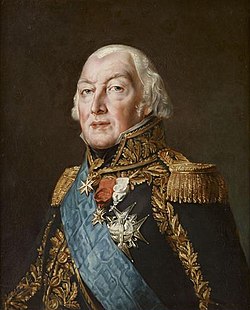|
François-Henri de Franquetot de Coigny
François-Henri de Franquetot de Coigny, duc de Coigny (28 March 1737 – 19 May 1821) was a Marshal of France. Early lifeHe was the son of Jean, Marquis de Coigny (1702–1748) and the grandson of François de Franquetot de Coigny, another Marshal of France.[1] When he was eleven, his father was killed in a duel and at age fifteen, de Coigny entered the musketeers.[2] CareerDe Coigny first served in the Seven Years' War where as a cavalry general he took part in the conquest of Hanover. Having fought at Hastenbeck and Minden, he transferred to the army of the Count of Clermont under whom he served in the Battle of Krefeld. Promoted to Colonel General of the Dragoons in 1771, the following year he was appointed Governor of Cambrai. In 1787 he was made a peer of France. When the French Revolution broke out De Coigny decided to emigrate. In 1791 he joined the émigré army with whom he served against the French Republic during the early stages of the French Revolutionary Wars. He commanded the Maison du Roi until its disbandment in 1792, after which he was charged by the Count of Provence with several diplomatic missions. De Coigny entered Portuguese service thereafter and, following the abdication of Napoleon, ultimately returned to France. From 1816 to 1821 he was Governor of Les Invalides. In 1816, De Coigny was made a Marshal of France. He died on 19 May 1821. Marriage and issueDe Coigny was married to Marie Jeanne de Bonnevie. Together, they were the parents of a son and daughter:
DescendantsThrough his only daughter, he was a grandfather of Françoise, duchesse de Praslin, who was believed to have been murdered by her husband, Charles de Choiseul, Duke of Praslin in August 1847. While awaiting trial by the Chamber of Peers, the Duke committed suicide by arsenic.[3] Following hard on the heels of the Teste–Cubières political corruption scandal revealed in May 1847, the affair only added to the popular discontent with the July Monarchy which culminated in the French Revolution of 1848. References
|
||||||||||||||||||||||||||||||||||||
